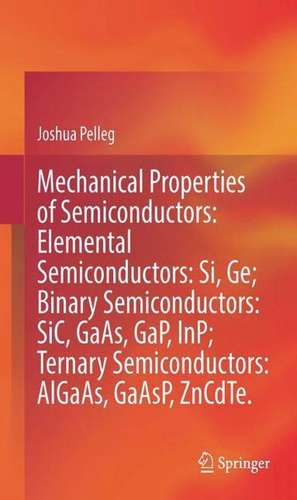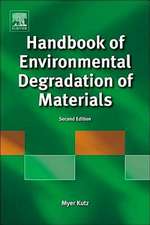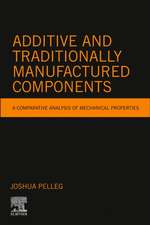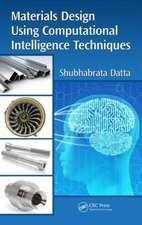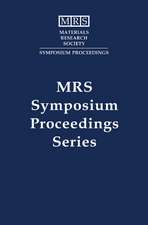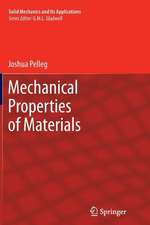Mechanical Properties of Semiconductors: Exploring Elemental, Binary, and Ternary Systems
Autor Joshua Pellegen Limba Engleză Hardback – 3 mai 2024
Chapter 5 covers static deformation, including hardness and brittle behavior, while Chapter 6 explains the phenomenon of work hardening and its relationship to dislocations in the material. Chapter 7 introduces time-dependent deformation, specifically creep, which is influenced by temperature. Fracture, a common mode of failure in semiconductors, is discussed in Chapter 8, with an emphasis on stress rupture and the inability to carry an applied load. Chapter 9 addresses the unique mechanical behavior of small size semiconductor specimens in the nano scale. Finally, Chapter 10 explores the environmental effects on the mechanical properties of semiconductors.
Overall, this book provides a comprehensive and detailed understanding of the mechanical behavior of some elemental, binary and ternary semiconductors, which is crucial for developing and designing semiconductor-based technologies.
Preț: 1228.29 lei
Preț vechi: 1497.92 lei
-18% Nou
Puncte Express: 1842
Preț estimativ în valută:
235.06€ • 244.01$ • 196.00£
235.06€ • 244.01$ • 196.00£
Carte disponibilă
Livrare economică 03-17 martie
Preluare comenzi: 021 569.72.76
Specificații
ISBN-13: 9783031216589
ISBN-10: 303121658X
Pagini: 332
Ilustrații: XVIII, 332 p. 339 illus., 113 illus. in color.
Dimensiuni: 155 x 235 mm
Greutate: 0.75 kg
Ediția:2024
Editura: Springer International Publishing
Colecția Springer
Locul publicării:Cham, Switzerland
ISBN-10: 303121658X
Pagini: 332
Ilustrații: XVIII, 332 p. 339 illus., 113 illus. in color.
Dimensiuni: 155 x 235 mm
Greutate: 0.75 kg
Ediția:2024
Editura: Springer International Publishing
Colecția Springer
Locul publicării:Cham, Switzerland
Cuprins
Basic Concepts of Semiconductors.- Elastic Properties.- Plastic deformation.- Defects:.- Deformation in Semiconductors.- Time dependent deformation (Creep).- Fatigue (Cyclic Deformation) in Semiconductors.- Fracture in semiconductors.- Nanometric Semiconductors.- Environment epilogue.
Notă biografică
Joshua Pelleg received his B.Sc. in Chemical Engineering at the Technion–Israel Institute of Technology, Haifa, Israel, M.Sc. in Metallurgy at the Illinois Institute of Technology, Chicago, IL, and Ph.D. in Metallurgy at the University of Wisconsin, Madison, WI. He has been in the Ben-Gurion University of the Negev (BGU) Materials Engineering Department in Beer-Sheva, Israel, since 1970, and was among the founders of the department, and served as its second chairman. He was the recipient of the Samuel Ayrton Chair in Metallurgy. He specializes in the mechanical properties of materials and the diffusion and defects in solids. He has chaired several university committees and served four terms as the chairman of Advanced Studies at Ben-Gurion University of the Negev. Prior to his work at BGU, he acted as the assistant professor and then associate professor in the Department of Materials and Metallurgy at the University of Kansas, Lawrence, KS. He was also a visiting professor in the Department of Metallurgy at Iowa State University; at the Institute for Atomic Research, US Atomic Energy Commission, Ames, IA; at McGill University, Montreal, QC; at the Tokyo Institute of Technology, Applied Electronics Department, Yokohama, Japan; and in Curtin University, Department of Physics, Perth, Australia. His non-academic research and industrial experience includes the chief metallurgist in Urban Metallurgical Works Ltd., Netanya, Israel; research engineer in International Harvester Manufacturing Research, Chicago, IL; associate research officer for the National Research Council of Canada, Structures and Materials, National Aeronautical Establishment, Ottawa, ON; physics senior research scientist, Nuclear Research Center, Beer-Sheva, Israel; Materials Science Division, Argonne National Labs, Argonne, IL; Atomic Energy of Canada, Chalk River, ON; visiting scientist, CSIR, National Accelerator Centre, Van de Graaf Group Faure, South Africa; Bell Laboratories, Murray Hill, NJ; and GTE Laboratories, Waltham, MA. His current research interests are mechanical properties, diffusion in solids, thin-film deposition and properties (mostly by sputtering) and the characterization of films, among them various silicides. His research activity is summarized in his publications in various scientific journals and in ten books published by Springer and Elsevier
Textul de pe ultima copertă
This book is a comprehensive guide to understanding the mechanical behavior of specific semiconductors: Elemental Semiconductors: Si, Ge; Binary Semiconductors: SiC, GaAs, GaP, InP; Ternary Semiconductors: AlGaAs, GaAsP, ZnCdTe . The chapters are arranged in a logical sequence, starting with the basics of semiconductors in Chapter 1 and gradually progressing to more complex topics. Chapter 2 delves into the elastic properties and yielding concept, while Chapter 3 discusses plastic deformation and its relation to semiconductor stability. The important role of defects in semiconductors is explored in Chapter 4, with a focus on point defects and dislocations.
Chapter 5 covers static deformation, including hardness and brittle behavior, while Chapter 6 explains the phenomenon of work hardening and its relationship to dislocations in the material. Chapter 7 introduces time-dependent deformation, specifically creep, which is influenced by temperature. Fracture, a common mode of failure in semiconductors, is discussed in Chapter 8, with an emphasis on stress rupture and the inability to carry an applied load. Chapter 9 addresses the unique mechanical behavior of small size semiconductor specimens in the nano scale. Finally, Chapter 10 explores the environmental effects on the mechanical properties of semiconductors.
Overall, this book provides a comprehensive and detailed understanding of the mechanical behavior of some elemental, binary and ternary semiconductors, which is crucial for developing and designing semiconductor-based technologies.
Chapter 5 covers static deformation, including hardness and brittle behavior, while Chapter 6 explains the phenomenon of work hardening and its relationship to dislocations in the material. Chapter 7 introduces time-dependent deformation, specifically creep, which is influenced by temperature. Fracture, a common mode of failure in semiconductors, is discussed in Chapter 8, with an emphasis on stress rupture and the inability to carry an applied load. Chapter 9 addresses the unique mechanical behavior of small size semiconductor specimens in the nano scale. Finally, Chapter 10 explores the environmental effects on the mechanical properties of semiconductors.
Overall, this book provides a comprehensive and detailed understanding of the mechanical behavior of some elemental, binary and ternary semiconductors, which is crucial for developing and designing semiconductor-based technologies.
Caracteristici
Comprises 10 to 11 chapters Covers all aspects of the mechanical properties including static-, cyclic-, and time-dependent deformation Presents the mechanical properties of these structural materials
